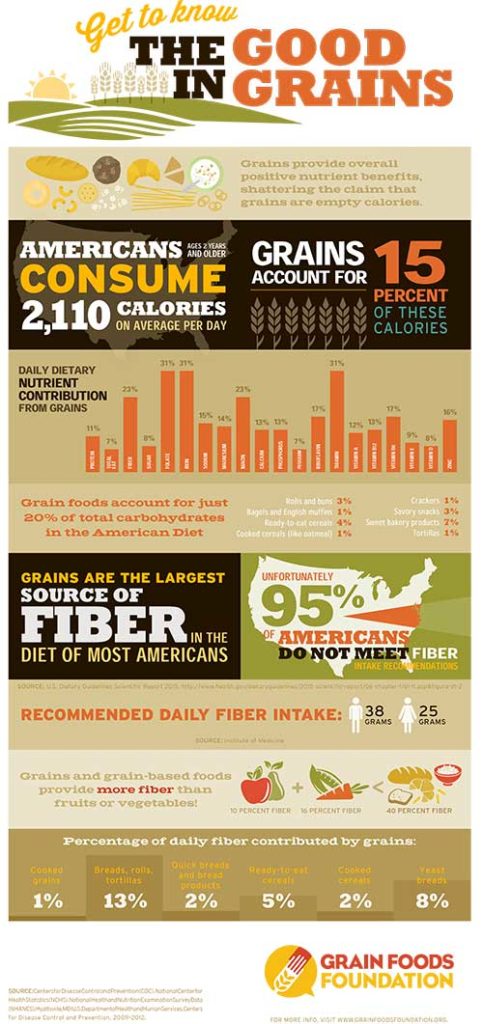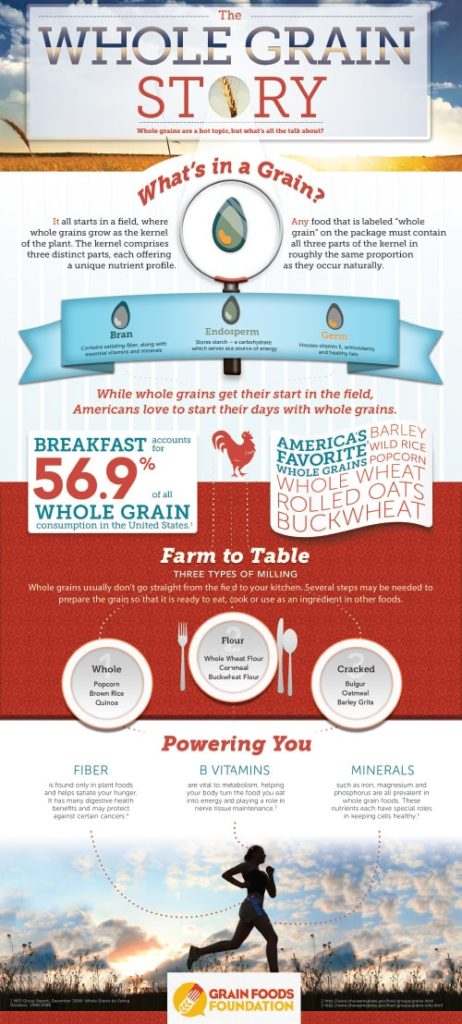Grain foods are one of the major food groups
as part of an overall healthy eating plan. MyPlate, which is the tool developed by the U.S. Department of Agriculture (USDA) to help Americans make healthful choices, allots about one-quarter of a standard plate for grain foods, approximately the same amount as proteins, fruits, and vegetables.1 When you think about a meal for breakfast, lunch, or dinner, you should aim to have about one-quarter of that meal coming from grain food sources. That can be as simple as a plate of chicken with rice and vegetables, or a mixed-dish meal such as chicken-noodle soup with vegetables, or a Hawaiian pizza with ham, cheese, and pineapple with tomato sauce (the pizza crust provides grains).
And while MyPlate encourages Americans to make half their grains come from whole grain sources, there’s a role for enriched grains, too. Enriched grains – which are devoid of the grain’s bran and germ – tend to be fortified with essential nutrients. In fact, in 1998 the Food and Drug Administration (FDA) required that all enriched wheat products be fortified with folic acid as a way to prevent neural tube defects during early pregnancy.2 The mandatory folic acid fortification is one of the most successful fortification programs to date, and is responsible for a 35% reduction in neural tube defects since its inception.3 Food intake data shows that people are getting more folic acid from their grain food sources than they are from vegetables.4 Fortification of grains has also contributed to helping children meet their nutrient needs.5
Removing enriched grains from the diet entirely would also have unintended, negative consequences. A modeling study found that if only whole grains were required in the diet, with enriched grains or other substitutions not allowed, people would be at risk for nutritional deficiency. That’s because whole grains alone would be unable to fill the nutrient deficits left by fortified, enriched grains.6
Grains That Reign Supreme
Breads, cereal, pasta and rice are among the foods most associated with better diet quality and intake of essential nutrients, according to analyses done on food intake of both adults7 and children.8,9 Breads, including rolls, tortillas, as well as ready-to-eat cereals are meaningful contributors of folate, iron, thiamin, niacin and dietary fiber in children’s diet.9 Pasta, cooked cereals and rice were also associated with lower total fat and saturated fat intake of U.S. adults.7
References
1 U.S. Department of Agriculture. ChooseMyPlate.gov Website. Washington, DC. Grains: https://www.myplate.gov/eat-healthy/grains.
2 U.S. Food and Drug Administration. Food standards: amendment of standards of identity for enriched grain products to require the addition of folic acid. Fed Reg. 1996;61(44). http://www.gpo.gov/fdsys/pkg/FR-1996-03-05/pdf/96-5014.pdf Accessed 22 May 2016.
3 Centers for Disease Control and Prevention (CDC). Updated Estimates of Neural Tube Defects Prevented by Mandatory Folic Acid Fortification — United States, 1995–2011. MMWR Morb Mort Wkly Rep. 2015: 64(01);1-5.
4 Dietrich M, Brown CJ, Block G. The effect of folate fortification of cereal-grain products on blood folate status, dietary folate intake, and dietary folate sources among adult non-supplement users in the United States. J Am Coll Nutr.2005;24:266–74.
5 Keast DR, Fulgoni VL, Nicklas TA, O’Neil CE. Food sources of energy and nutrients among children in the United States: NHANES 2003–2006. Nutrients. 2013;5:283–301.
6 U.S. Department of Agriculture and U.S. Department of Health and Human Services (USDA/HHS). Scientific report of the 2005 Dietary Guidelines Advisory Committee: Advisory Report to the Secretary of Health and Human Services and Secretary of Agriculture. Washington: USDA, Agricultural Research Service; 2005.) and (U.S. Department of Agriculture and U.S. Department of Health and Human Services (USDA/HHS). Scientific Report of the 2015 Dietary Guidelines Advisory Committee: Advisory Report to the Secretary of Health and Human Services and Secretary of Agriculture. 2015. Washington: USDA, Agricultural Research Service; 2015. http://health.gov/dietaryguidelines/2015-scientific-report/PDFs/Scientific-Report-of-the-2015-Dietary-Guidelines-Advisory-Committee.pdf.
7 Papanikolaou Y, Fulgoni VL. Certain grain food patterns are associated with improved 2015 dietary guidelines shortfall nutrient intakes, diet quality, and lower body weight in US adults: results from the national health and nutrition examination survey, 2005–2010. Food Nutr Sci. 2016;7:772–81.
8 Papanikolaou Y, Jones JM and Fulgoni VL. Several grain dietary patterns are associated with better diet quality and improved shortfall nutrient intakes in US children and adolescents: a study focusing on the 2015–2020 Dietary Guidelines for Americans. Nutrition Journal. 2017;16:13
9 Papanikolaou Y, Fulgoni VL. Certain Grain Foods Can Be Meaningful Contributors to Nutrient Density in the Diets of U.S. Children and Adolescents: Data from the National Health and Nutrition Examination Survey, 2009–2012. Nutrients 2017;9:2.




